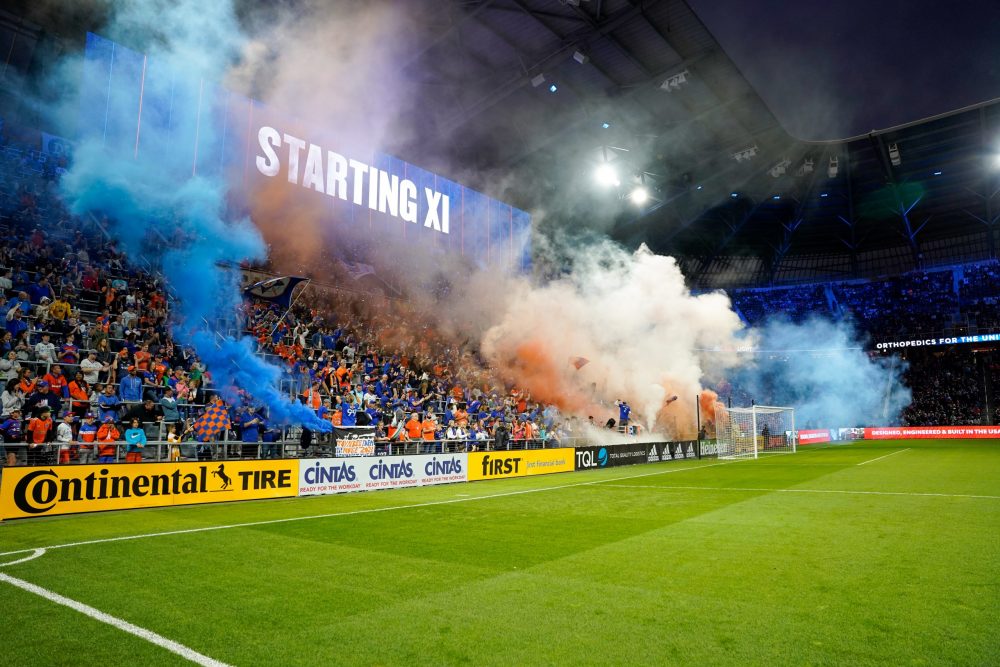You probably didn’t expect to open up CincinnatiSoccerTalk.com to find a story about the Pilgrims on the home page. However, fear not! You are not in your middle school history class, and this is in fact a soccer article. This is the story of the soccer-playing Pilgrims and a story of Cincinnati’s first international friendly. It brings us all the way back to 1909, early in the city’s second century.
For some perspective, the Williams’ Company Directory of Cincinnati of that year reports that the city is currently constructing the Cincinnati Southern Railway, of which it is immensely proud. Also noted is that the population sits at around 600,000 people. Today it is at about 2.3 million. Elsewhere in 1909, Cincinnati’s own William Howard Taft was inaugurated as the 27th president of the United States. In the sports world, Ty Cobb and Honus Wagner were the superstars, as they dominated the diamond. In Cincinnati, the Reds played a rather mediocre season. The team, led by manager Clark Griffith, finished with a record of 77-76, good for fourth in the National League.
Amidst all of this came the Pilgrims of England, an amateur club making their second tour of the United States. First reports of soccer in Cincinnati date back to the late 1800s as the Cincinnati Soccer League (CSL) played its first season. The game was brought to the city by Irish and German immigrants and quickly grew in popularity. In fact, Cincinnati is credited as one of the first cities to popularize soccer, although not as intense as in places like New Jersey and St. Louis.
Frequent coverage by the Cincinnati Enquirer promoted the drama and fanfare of the highly exciting games. The CSL featured perennial contenders such as the Potter-Thistles, the Cincinnati Gyms and the Fourth Intermediate Alumni (F.I.A.). Aside from these mainstays, a rotating basis of teams composed of police, firefighters, American Legion members and other groups within the city came and went. The excitement and popularity of the CSL gained national and international attention, even in 1909. Enter the Pilgrims of England.
The Pilgrims, by today’s accounts, were a group of amateur players from England keen on teaching the Yanks a lesson or two about how football was to be played. The goal of their American trips was to promote and enhance the sport in the United States, and thus they only chose to attend cities with an already healthy soccer culture. Their first American tour, in which they played 17 games, resulted in a 14-2-1 record with 95 goals for and 16 goals against. It was quite the dominant performance.
When it was announced that they would be making a second tour of America in 1909, Cincinnati was included on that list. This was a high honor for the city as it meant it was one of the most prominent destinations of the growing sport that had only recently been introduced to America. As a stop on the 22-game slate, Cincinnati put together an all-star team of soccer players from the CSL. However, they wanted this experience to be truly unique, fueling anticipation about the prospects of something never before seen in soccer.
The game was first announced in the June 27th edition of the Cincinnati Enquirer and the grand surprise was officially unveiled. The game was to be played at night, under the glow of the newly invented electric lights. This was practically unheard of in this era. In fact, the first official baseball night game didn’t happen for another 26 years, when the Cincinnati Reds defeated the Philadelphia Phillies 2-1 on May 24, 1935, at Crosley Field. The Pilgrims game against the Cincinnati All-Stars was one of the first tests for this type of lighting system for a sporting event. It was safe to say that excitement was already building.
By September, a date and location had been announced for the contest. The date for the Pilgrims and the Cincinnati All-Stars was to be October 14th at League Park, better known later as Palace of the Fans and the home of the Cincinnati Reds from 1884 to 1911. The former site of League Park is interestingly just under a mile from the present-day home of soccer in Cincinnati, TQL Stadium, sat in an industrial area just north of Union Terminal.
In preparation for the game, the Cincinnati man known as “Manager Sachs,” coach of the CSL team known as the Nationals, sent a member of his team named G. Waterman to scout the Pilgrims in the East before they arrived in Cincinnati. Waterman reported back that the Pilgrims were elite competition, unbeaten in their first nine games. The Pilgrims began to be promoted among Cincinnati newspaper circles as the “Champions of England.” This was rather comedic considering we know today that the Pilgrims were not champions of anything. They were simply an amateur team formed with the sole purpose of touring America and beating the snot out of anyone deemed worthy of hosting them.
That being said, the talent of the Pilgrims was undeniable. Their players made careers out of playing for the top clubs in England such as Sunderland, Arsenal, Fulham and Southampton in an age when professionalism was first introduced to English soccer. Their arrival in Cincinnati was a massive milestone for the city’s growing interest in soccer and I assure you that the Cincinnatians taking the field wanted nothing more than to beat what they thought to be the champions of England.
On September 26th, a full column devoted to the game ran in the Enquirer. Finally, we got the first word of the English team that would play in Cincinnati in only a few short days. The lineup was loaded with star power, and read as follows:
Goalkeeper: H.M. Lemoine
Club: Woolwich-Arsenal
Notable Fact: Featured in an international competition against Wales. “One of the finest custodians in all England.”
Right Full Back: Frederick M. Milnes (captain)
Club: Sheffield United
Notable Fact: “Is said to have received more medals for football than any other player in the world.” Rumored to be a millionaire.
Left Full Back: J.J. Bayley
Club: Clopton
Notable Fact: Won three cup medals. Stood at 6’ 5.”
Right Half Back: W.O. Clemenson
Club: Darlington Newcastle United
Notable Fact: House furnished by trade.
Center Half Back: H.C. Littlewort
Club: Fulham
Notable Fact: Also a great cricket player.
Left Half Back: George Simon
Club: Nottingham
Notable Fact: Exceled in the engineering and machinery business.
Outside Right: H.J. Eastwood
Club: Clopton
Notable Fact: Won the English Cup the previous year and one of the most promising players in all of England.
Inside Right: E.J. Cotton
Club: Woolwich-Arsenal
Notable Fact: The only Irish player on the team.
Center Forward: G.R. Hoare
Club: Woolwich-Arsenal
Notable Fact: A sculptor by trade.
Center Forward: J. Brown Sim
Club: Sheffield United
Notable Fact: A surgeon at the Sheffield Royal Hospital.
Inside Left: T.T. Fitchie
Club: Woolwich-Arsenal
Notable Fact: The star of the team and said to be the greatest player in all of England.
Outside Left: C. Coopland
Club: Glossop
Notable Fact: A schoolmaster in Sheffield during the offseason.
Outside Left: William Davidson
Club: Falkirk
Notable Fact: An accountant by profession.
It was clear that the talent of the Pilgrim team was not to be questioned. The article concluded with a schedule of Pilgrim games, featuring Cincinnati. The article claimed that this would be the first football game played at night under electric lights in the history of the sport.
As the date of the fateful game approached, the Pilgrims continued to roll through their opponents with no remorse. By the time they reached Cincinnati, they had scored 49 goals while only conceding one in six matches. On October 8th, the lineup representing Cincinnati was announced. The club did not possess the well-known names of the Pilgrims, instead featuring players from clubs such as “The Y.M.C.A.’s,” “The Ashland, Ky.’s,” “The Thistles” and “The Nationals.” The team planned to sport a fashionable kit of black shirts with white shorts to counter the Pilgrims’ white shirts and black pants.
At last, the day of the fabled contest arrived. The Pilgrims, arriving in town the previous night, decided to add a little extra importance to the game. They offered all members of the Cincinnati team a free trip to England if they could beat them when the two sides squared off at 8 p.m. the following night. Moments before the game, Cincinnati player Jim Brown was chosen to be the referee. He gave up his spot in the starting lineup to a bench player to perform this duty.
It seems to me that, in this case, the Cincinnati strategy should have been to choose the best Pilgrim player to be the referee, nullifying their ability from the opposition. Nevertheless, a large crowd was expected for the game and more seating had to be opened to accommodate all of the fans. The kickoff was approaching and everyone held their breath to see how the Cincinnati All-Stars would perform against this giant of English soccer.
This is the part where you expect me to say that the Cincinnatians defeated the English in one of the greatest sporting upsets of all time. They took their victory trip to England and lived happily ever after. Unfortunately, this was not the case. The Cincinnati team fell 9-0 that night in front of several thousand fans. However, life isn’t always about the winning score, and in many ways, there were plentiful other victories to be taken from this match.
For starters, the Pilgrims accomplished their goal of spreading soccer throughout America. In Cincinnati alone, multiple articles ran explaining the excitement that the sport brought and theorized that it could one day stand alongside baseball in popularity. The Pilgrims finished their 1909 tour of America with a 16-4-2 record, allowing only 13 goals while scoring 123. The Cincinnati team was by no means their largest victory as they went on to beat teams by scores of 12-0 and 14-0.
For Cincinnati, the victories were monumental. Several thousand fans turned out for what ended up being one of the largest Cincinnati sporting events of the time. The electric lighting system worked flawlessly and was to the approval of the English, who had never seen anything like it. The model system was used to improve lit sporting events leading up to the modern systems that we have today.
Lastly, and perhaps most importantly, the unification of Germans, Irish, English and others, all different backgrounds, all joined together as Cincinnatians to take on a near-unbeatable foe. The Cincinnati team that took the field against the Pilgrims on that pristine October night showed the city and the nation what soccer in America could be. They showed the passion and support of the sport. More importantly, at a field just a mile away from the current home of soccer in Cincinnati, they brought the sport to our city. We owe a lot to the 11 men that took the field that day. Without them, who knows if just over a hundred years later we’d be under a mile away celebrating our beloved team.













